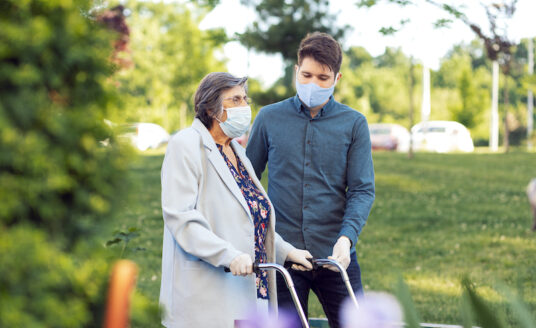The number of COVID-19 cases continues to climb and the projected peak flu season will fall between December and February. According to Lynn Licklider, Bethesda’s Corporate Director of Clinical Services, cases can occur as early as September and October, depending on the flu strain.
Most colds in the U.S. happen in the fall and winter as well. With all three occurring at the same time, there is cause for concern and possible confusion when it comes to determining the differences between these illnesses due to common symptoms.
As a result, seniors must monitor their health closely during these months, as they are the most susceptible to the serious effects of these illnesses.
COVID-19 Symptoms and Responses
Some of the symptoms for COVID-19 include:
- Cough
- Fatigue
- Runny or stuffy nose
- Headache
- Sore throat
- Fever
- Body aches
- Shortness of breath
- Loss of taste or smell
As there is no vaccine or proven cure for the virus yet, the best defense against COVID-19 remains wearing a face mask over the mouth and the nose, social distancing (6 feet or more), hand washing (at least 20 seconds), and disinfecting objects.
If you have been around a person who has the virus, you should isolate yourself in your home for 14 days after your last exposure to that person. Symptoms may appear anywhere from 2 to 14 days after exposure.
“COVID-19 affects people in different ways,” Lynn says. “If symptoms consistent with the virus do occur, continue to isolate yourself from others.” People should contact their physician before making a medical appointment, and avoid visiting a hospital emergency room unless the following symptoms occur:
- Trouble breathing
- Persistent pain or pressure in the chest
- New confusion
- Inability to wake or stay awake
- Bluish lips or face
According to the Centers for Disease Control and Prevention (CDC), this is not a list of all possible symptoms. It is advised to call your medical provider “for any other symptoms that are severe or concerning to you.”
A person can have COVID-19 with no symptoms and still be contagious. According to Lynn, up to 35 percent of infected people never show symptoms. “This is why mask wearing and social distancing is so important.”
“Even though any type of mask is better than no mask at all, surgical masks and N95/KN95 masks provide greater protection and should be worn if a person has a medical condition that makes them more susceptible or if they are immunocompromised,” Says Lynn.
There is evidence for immunity from the virus after someone has contracted it and survived, but the length of the immunity has not been determined. Lynn says it is generally at least 12 weeks.
The effects of the virus can stay with a person for an extended period of time during recovery, with symptoms like fatigue and the loss of taste and smell lingering longer than others.
If a call is placed to 911 or to an emergency department requesting transport to a hospital, please advise the operator that COVID-19 may be the cause of the symptoms.
Flu Symptoms and Responses
Both COVID-19 and the flu are viruses that attack the respiratory system and have many symptoms in common. They are both spread by respiratory droplets and close contact. However, they are treated differently. A list of flu symptoms includes:
- Cough
- Fatigue
- Runny or stuffy nose
- Headaches
- Sore throat
- Fever
- Body aches
- Shortness of breath
- Diarrhea
Medical professionals have noted one major difference: COVID-19 can cause a change in, or loss of, taste or smell. This has not been noted in flu patients.
Because of the overlap, the precautions of isolation and contacting a physician advised for COVID-19 is also advised for the flu. Also, seek emergency help if symptoms become severe, such as a high fever (103 degrees F or higher) or a sustained fever. Especially a fever accompanied by a severe headache, throat swelling, mental confusion or persistent vomiting.
Remember the flu can be fatal, particularly in senior adults.
For healthy people, flu symptoms usually last five to seven days after they first appear. People who have had a flu shot but still contracted the flu may have symptoms that are less severe and last a shorter period of time.
The best defense against the flu is an annual vaccination in the fall by the end of October. The CDC recommendation is that everyone 6 months and older should be vaccinated every season with rare exceptions.
Some studies show the drug Tamiflu, taken early after contracting the flu, may be effective in treating or lessening symptoms. However people with kidney disease need to have lab work performed before taking Tamiflu. There are over-the-counter medications to assist with relieving symptoms.
Cold Symptoms and Responses
Cold symptoms include:
- Cough
- Fatigue
- Runny or stuffy nose
- Headaches
- Sore throat
- Body aches
- Sneezing
“The common cold is also a coronavirus like COVID-19 and shares many symptoms with it and the flu,” Lynn says, “It also spreads through droplets in the air or touching contaminated surfaces and then touching your eyes, nose or mouth.”
The flu symptoms of fever, chills, aching muscles, and joints tend to distinguish it from the sore throat and runny nose of a cold. Cold symptoms begin two or three days after infection and can last up to 10 days.
There is no cure for the common cold. Some over-the-counter medications may provide symptom relief. Drinking plenty of fluids and resting until the cold passes is recommended.
The same basic defense against the common cold is a similar to that for COVID-19: washing your hands often with soap and water; not touching your eyes, nose, and mouth with unwashed hands; avoiding close contact with people who are sick; staying home when you are sick; and disinfecting objects and surfaces.
Also, contact your physician about your symptoms before making an appointment.
Seasonal Allergies Symptoms and Responses
Seasonal allergies are less common during the winter and occur most often when plants release their pollens during warmer weather. The timing of the allergy season depends upon where you live. During a year, it is estimated that 50 to 60 million people in the U.S. struggle with allergies.
The most common symptoms produced by the reaction of your immune system to the pollens in the air are:
- Cough
- Runny or stuffy nose
- Headaches
- Sore throat
- Sneezing
- Itchy eyes
Over-the-counter medications provide some relief. They include antihistamines, decongestants, and nasal sprays. According to Lynn, people should check with their physician first, as some over-the-counter and allergy medications should be avoided if a person is on certain blood pressure medications.
If these remedies don’t work, your physician may recommend tests to find out what allergens trigger your symptoms. Some people require allergy shots; regular injections that, over time, reduce the immune system reaction that causes symptoms.
The Mayo Clinic has some suggestions for allergy sufferers:
- Stay indoors on dry, windy days. The best time to go outside is after a rain
- Delegate lawn mowing, weed pulling and other gardening chores that stir up allergens to others
- Remove clothes worn outside and shower
- Pollen masks are available if you are outdoors
- Check when pollen counts are high
- Avoid outdoor activity early in the morning when pollen counts are highest
A Healthy Defense
As we age, our bodies become less able to defend us from illness. So, in addition to taking the precautions and steps above, it is wise to give ourselves the best chance of emerging well from an illness by consistently taking care of ourselves. A proper diet, exercise, weight control, managing chronic illnesses, and staying in touch with your physician are practices that provide a better defense against illness.
With all these symptoms overlapping it is hard to remember, what a sore throat could be, what a fever means and what the common cold entails. BJC HealthCare provides a great and easy to read chart on the illnesses and symptom comparisons listed above.
Stay healthy this cold and flu season, especially during the COVID-19 pandemic, by following our Senior Health & Wellness tips.



